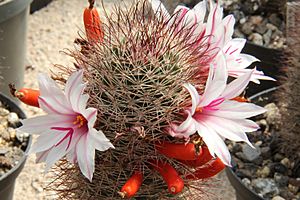Mammillaria fraileana facts for kids
Quick facts for kids Mammillaria fraileana |
|
|---|---|
 |
|
| Scientific classification | |
| Genus: |
Mammillaria
|
| Species: |
fraileana
|
The Mammillaria fraileana is a type of cactus that grows in Mexico. It's one of about 200 different kinds of cacti in the Mammillaria family. You can find this cactus along the eastern coast of the southern part of the Baja California Peninsula. It usually grows in dry, rocky areas, often on granite soil or even right on top of rocks, sometimes without any soil at all! The types of minerals in the rocks nearby can affect how many of these cacti grow there.
The places where Mammillaria fraileana lives are full of interesting succulent plants. Many of these plants are endemic, meaning they are found only in that specific area and nowhere else in the world. Good news: there are no big threats known for this cactus right now.
Contents
What Does This Cactus Look Like?
Cacti in the Mammillaria family have a special feature: their areole (the part where spines grow) is split into two sections. The top part of a bump, called a tubercle, holds the cactus's spine. The bottom part of the tubercle is where the flowers and fruits grow.
The Mammillaria fraileana has its own unique look:
- It grows in groups or clusters that form slowly and aren't perfectly shaped.
- Its stems are shaped like cylinders, usually about 3 to 4 centimeters (1.2 to 1.6 inches) wide.
- The cactus body is green, but it can turn a bit reddish if it gets a lot of sunlight.
- Its tubercles are pyramid-shaped and don't have a milky sap inside.
- The roots are thin and spread out like fibers.
- This cactus has 11 to 12 thin, white spines that stick out around the sides. These are called radial spines and are about 8 to 10 millimeters (0.3 to 0.4 inches) long.
- It also has 3 to 4 darker, thicker spines in the center, called central spines. These are usually about 10 millimeters (0.4 inches) long.
- The flowers are light pink with a darker pink line down the middle. They are about 2.5 to 3 centimeters (1 to 1.2 inches) wide.
- The part of the flower that collects pollen, called the stigma, is bright pink.
- After flowering, the cactus grows a red fruit that holds small black seeds.
- Mammillaria fraileana usually blooms from May to September.
How to Grow This Cactus
Growing Mammillaria fraileana can be a bit tricky, but it can grow well if it has good air circulation. Since this cactus loves dry places, it's very sensitive to too much water. It needs soil that lets air move through it easily. The soil mix should also be a little bit acidic.
It's best to avoid using peat or other types of humus (decayed plant material) in the soil, as well as limestone. These can be bad for its growth. Mammillaria fraileana needs as much sunlight as possible to grow and flower successfully, because it's used to warm climates. Cold weather and frost can also harm the plant.
Letting the plant rest in winter, even letting it shrink a bit (up to 25% of its summer height), can actually help it flower better when spring comes.
How This Cactus Helps Rocks Change
Scientists have found that Mammillaria fraileana is a "pioneer" cactus. This means it's one of the first plants to grow on rocks. These cacti often grow on rocks called rhyodacite. Studies show that these rocks break down more when the cacti are present. This suggests that the cactus helps with rock weathering, which is the process of rocks breaking down to form soil.
This small cactus helps by doing things like nitrogen fixation. This is a process where tiny bacteria living inside the cactus and on its roots turn nitrogen from the air into a form plants can use. Scientists have found many of these helpful bacteria in the stems and roots of wild rock-colonizing plants in the southern Sonoran Desert. While they haven't found them in the seeds yet, more studies are showing these bacteria living in the fruits of some Sonoran Desert cacti.
See also
 In Spanish: Mammillaria fraileana para niños
In Spanish: Mammillaria fraileana para niños

